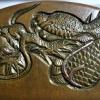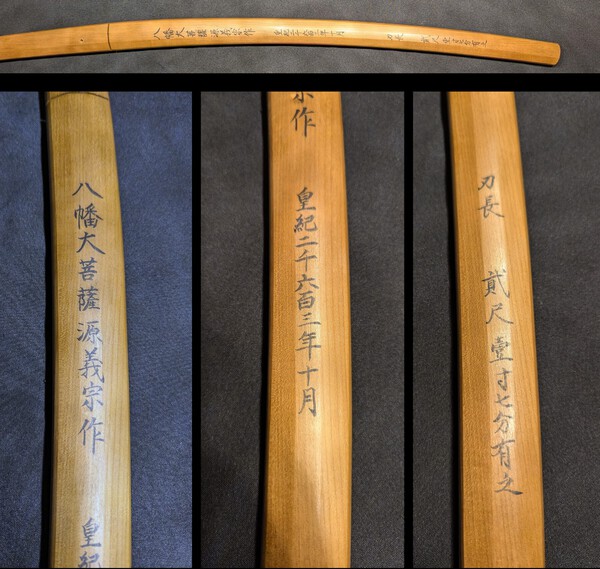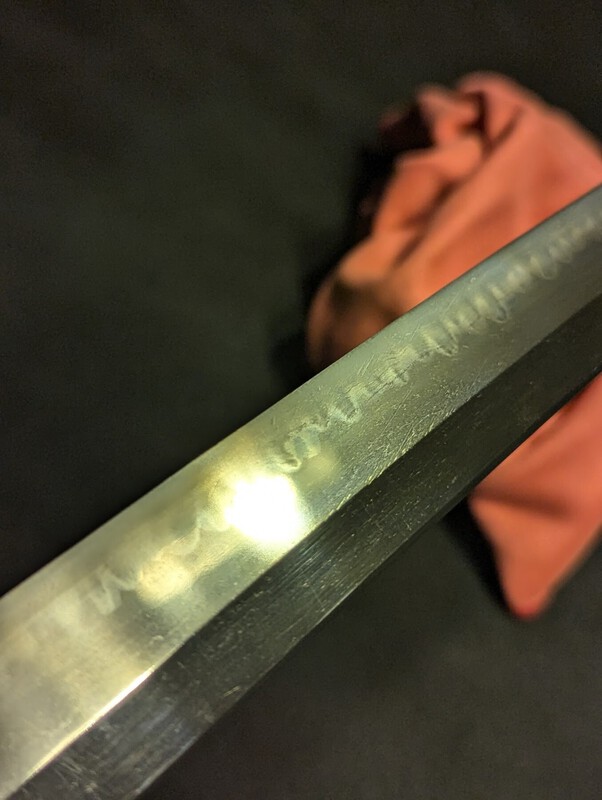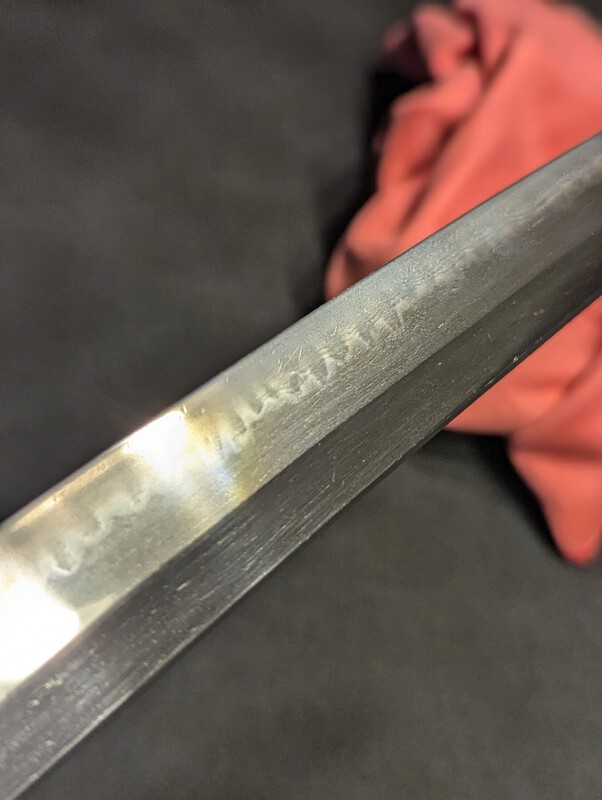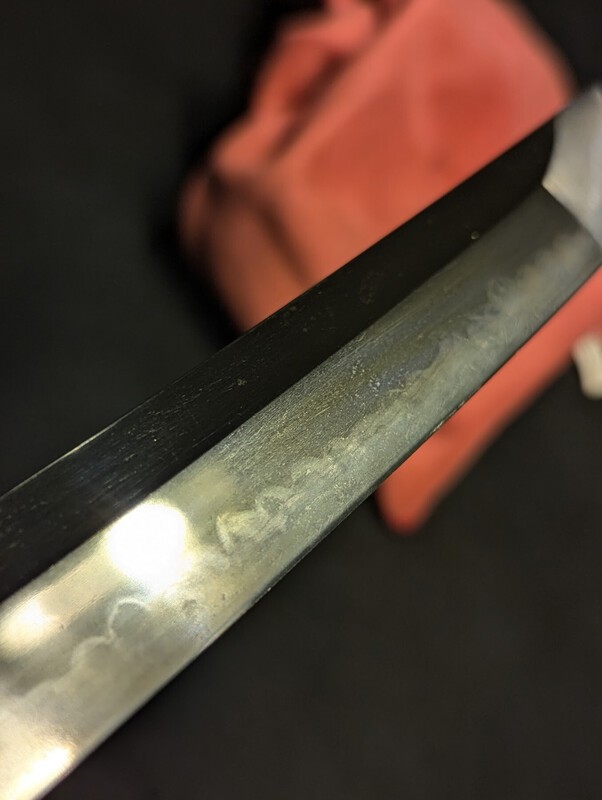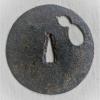All Activity
- Past hour
-
I understand your philosophy Dale. All i will say and keep it short because dont want this topic flying off into space. A new philosophy soon arises when you find you have no money. Anyone can find they lose their job, the misses wants half the house, whatever etc etc. Maybe im a little odd in that i like to see purchases hold their value. Its not about buying stuff to make money. I know people with "you only live once attitude so have fun and buy what you want". Anyways, going off track but they were never any happier. Back to eBay. Dont know if you saw the wanted thread on pine tsuba. Found five or more dealers on eBay all selling the same tsuba. I dont like ebay. Ive bought cheap tsuba too, from folks here.
-
If in fact, the Boshi does run off, this blade can't get papers, so not worth buying.
-
How about the fittings do they seem genuine and period correct and also do you think it’s an old blade which was remounted multiple times because of the three mekugi-ana? Also what do you think is a good price for this nihonto?
-
The handle is probably made from oak.
-
Tsuba is modern. Whats more important is wood tsuka is made of. I would treat nakago with oil here. Just a little bit to kill rust.
- Today
-
Kiipu started following Showa mei help
-

Cheap belt with leather hanger.
Rawa replied to Rawa's topic in Auctions and Online Sales or Sellers
Thank you. Some provenance is welcome. No extra pocket for sword itself. -
I can't see the yasurime in details, but for example, Echizen Seki. One of a few more or less generic possibilities.
-
Could someone also possibly determine which school or province it could have been forged in?
-
(1) A place to keep my magnets when not on the fridge (2) A balance point marker? 1 is not serious, and 2 is only slightly serious.
-
Hi Jon, is it possible to get an image of the tsuba unmounted from the blade? From the number of seppa I think the guard is unlikely to be original to the sword. A look at the seppa-dai might help with its identification.
-
Cheap belt with leather hanger.
Julien16 replied to Rawa's topic in Auctions and Online Sales or Sellers
Could be : 京〇 石原, second kanji is hard for me to read It looks like it could be a name : Kyo〇 Ishihara -
Alex what other purpose does money have? All money is ultimately wasted - that is how governments work . You can't take it with you when you die and leaving it to the kids just puts them on the same roundabout. Money is the ultimate slavery tool - get rid of it. Hell 90% of people wouldn't go to work if they had to do it just for fun, wages are a form of enforcement to keep the masses busy. [This political broadcast was brought to you by the money lenders association and the guild of "Make me richer than the Plebs"]
-
Offering a high quality gendaito by the famous swordsmith Takahashi Yoshimune. He was the brother the Gassan smith Takahashi Sadatsugu: the first Living National Treasure swordsmith. This blade is forged in an itame jihada with some flowing areas. The hamon is generally choji / juka-choji in the Bizen-den as it typical of his work. The blade is signed Minamoto Yoshimune and has an invocation of Hachiman Daibosatsu inscribed on the nakago as well. There is much activity, as shown in the photos below. The blade is in shirasaya with a sayagaki (unsigned). Bio per Markus Sesko below. YOSHIMUNE (義宗), Shōwa (昭和, 1926-1989), Ōsaka – “Hachiman-Daibosatsu Minamoto Yoshimune saku” (八幡大菩薩源義宗作), “Minamoto Yoshimune” (源義宗), “Takahashi Yoshimune” (高橋義宗), real name Takahashi Yoshimune (高橋義宗), he was the younger brother of Takahashi Sadatsugu (高橋貞次) and came originally from Ehime Prefecture, from 1913 he studied under Yokoyama Sukesada (横山祐定) and learned in 1918 also from Henmi Yoshitaka (逸見義隆) and even later also from Enju Kunitoshi (延寿国歳), he died in 1946, his speciality was a gunome-chōji in the Bizen tradition, he also worked as rikugun-jumei-tōshō, shinpin no retsu (Akihide), Special Honor Seat at the 6th Shinsaku Nihontō Denrankai (新作日本刀展覧会, 1941) $4,750 + shipping
-
Jon, it is not a KATANA but a military TACHI. The TSUBA is a recent imitation (not Japanese, I believe).
- Yesterday
-
@Jon D Hi Jon, there are examples and history of your swordsmith Katsumasa in the NMB Downloads (top of page) in paper Kojima Tokijiro Kanemichi and Kojima Tosho Family
-
Hi Markus, Thank you so much for taking the time to stop by this thread – it truly means a lot to me. I completely understand how busy things must be for you, especially with wrapping up the Tosogu Classroom project, and I really appreciate that you still make time to share your expertise here. I’m genuinely excited to hear your thoughts whenever you have a chance – no rush at all. Just knowing that you’ll chime in at some point already feels incredibly valuable, and I’m very grateful in advance. Best regards, Dennis
-
DENihontocollector started following Markus
-
Hi Markus, Thank you so much for taking the time to comment here – it really adds a lot of depth to this discussion. I found your note about the transmitted dates very interesting and it certainly helps to put things into perspective. Since this thread already touches on some key aspects of Norinaga’s work, I’m curious (and I’m sure others here would be too) how you personally approach these pieces when it comes to understanding which generation they might belong to. For example, in the case of my blade, the NBTHK and Tanobe sayagaki both attribute it to Norinaga without specifying the generation, but the workmanship has certain traits I’ve seen associated with early Shikkake. I’ve also posted the oshigata here in case it offers any points of comparison with known examples. I’d be very interested in your perspective – not necessarily as a firm verdict, but just in terms of what stands out to you or how you’d frame it in the broader Norinaga corpus. Thanks again for joining in, it’s great to have your insights here. Best regards, Dennis
-
I was pointed out to this thread to comment. As written in the preface to my publication: "Point (3) lists the handed-down artistic period where this date has to be taken with a grain of salt. Some dates are based on extant dated signatures and are more or less accurate, but most of them were transmitted again and again over the centuries with the initial listings often simply based on hearsay." What I am trying to say is that all of that is piling on and piling on atop of surviving period sources. There is re-assessment necessary on all levels, no exception. And that is where we are right now.
-
Hi Kirill, Thank you very much for your detailed insights regarding the relative standing of Hōshō compared to Shikkake. I find this perspective extremely valuable, especially since I am still learning how these subtle aesthetic differences influence market perception and appraisal. I agree that Hōshō’s tighter hada and more subtle style are highly appreciated – in fact, when I first started looking into Yamato schools, I initially considered Hōshō blades for precisely that reason. What fascinates me about Shikkake, however, is that despite being more “rustic,” it has a strong daitō tradition and often shows bold features (wide motohaba, powerful suguha with gunome, etc.), which gives it a distinct character among the Gokaden. Your comparison also helps me understand better why Shikkake seems to have an excellent TH-to-Jūyō pass rate, even if it doesn’t always reach the very top tier like Hōshō. This adds important context when thinking about both scholarly and market perspectives. Thanks again for sharing this – I really appreciate contributions like yours, as they make discussions like these so much richer.
-
Both the Jūyō papers and the sayagaki by Tanobe-sensei attribute the blade simply to Shikkake Norinaga, without mentioning any later generation. From what I’ve seen, Tanobe-sensei typically adds “Nidai” or another note when he considers a later generation, so the lack of such a qualifier strongly suggests he attributes it to the Shodai. the characteristics described in the sayagaki (and also reflected in the Jūyō zufu) align well with what’s documented for the founder’s work, so I feel confident this is meant to be first generation Norinaga. I really appreciate you raising this point – it’s something I wanted to be sure about myself. Best regards, Dennis

